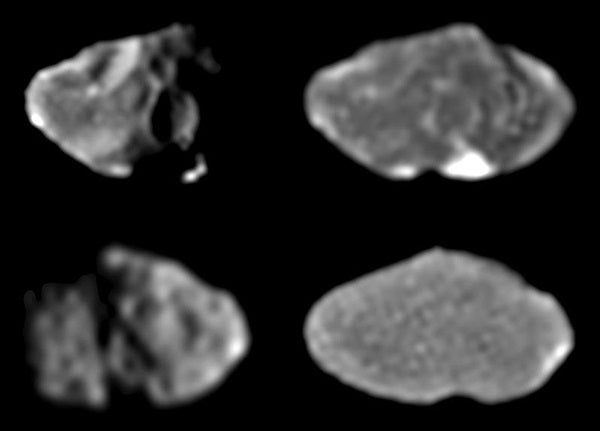Orbiting just 68,000 miles (110,000 kilometers) above Jupiter’s cloudtops, the giant planet’s inner moon Amalthea has a density less than water, says a team of planetary scientists. The finding, reported in this week’s Science, suggests the moon’s interior is a porous rubble pile and contains ice. This, in turn, says the moon did not form in its present location.
The team, led by John Anderson of the Jet Propulsion Laboratory in Pasadena, California, derived Amalthea’s volume using images taken by Voyagers 1 and 2 in 1979 and by the Galileo spacecraft in 1996 and 1997 to model its shape. The moon’s mass came from radio-tracking of Galileo’s trajectory through the moon’s gravitational field in a November 2002 encounter.
The resulting calculation shows that with a density of 0.86 (water = 1.0), Amalthea is even lighter than it would be if made of solid water ice (0.93). Realistic models for most outer-planet satellites typically assume a moon is a mixture of rocky material and ice. While the exact proportions are unknown with Amalthea, say the scientists, the moon’s porosity probably lies in the 30 to 55 percent range.
The moon’s appearance offers some clues to its interior. Amalthea’s elongated shape — 157 by 91 by 80 miles (250 by 146 by 128 km) — shows that, whatever the actual mix of rock and ice, the pressures at its center are not great enough to overcome the strength of the material, otherwise the moon would be rounder. Likewise, if Amalthea had ever been warmed enough to melt its ice, it would have become round.
Theoretical models for how Jupiter formed imply that temperatures where Amalthea now orbits were high enough to destroy water or ice. Therefore the oblong moon’s birth likely occurred elsewhere, say the scientists. They suggest several alternatives: Amalthea might have formed about where it is from pieces of other moons, but at a later time, when the proto-Jupiter nebula had cooled somewhat. Or it might have formed farther from Jupiter, beyond about the present orbit of Europa, again where conditions were cooler. Or Amalthea could have been born in a more-distant part of the solar nebula altogether.
In the latter two cases, Amalthea would have been captured into its present orbit, or otherwise moved there, driven by gravitational effects and interactions with other bodies.
In any event, the researchers say, these alternatives “pose challenges for models of giant planet satellite formation.”










